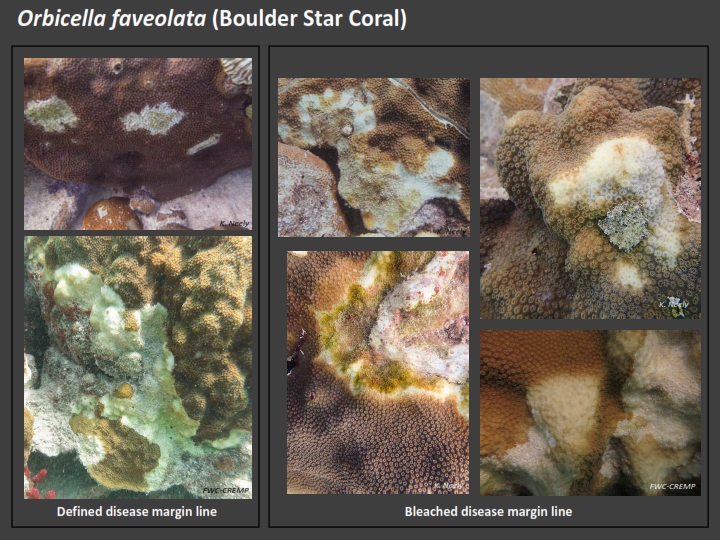Enfermedad de Pérdida de Tejido en Corales Duros (EPTCD)
Stony Coral Tissue Loss Disease (SCTLD) is a new lethal disease first reported in Florida in 2014 and it has been confirmed in the Caribbean Islands and the Mesoamerican Reef Region, in Mexico and north of Belize. This disease is affecting more than 20 species of corals especially the brain, pillar, star, and starlet corals and it has caused high coral mortality a few times. SCTLD is a particular threat to Caribbean reefs because of its large geographic range, extended duration, high rates of mortality, and the large number of coral species affected.Mexico July 2018 – On July 3, researchers from UNAM and CONANP discovered a reef near Puerto Morelos, Mexico to have a severe outbreak of a coral disease affecting similar species and exhibiting similar patterns as those in Florida.Belize June 2019 – Stony Coral Tissue Loss Disease (SCTLD) was first seen by Blue Ventures staff on June 21, 2019, in the Bacalar Chico Marine Reserve and has still only been reported in this area of northern Belize.
Scientifics and Managers of the Marine Natural Protected Areas have identified that sick colonies display multiple lesions and quickly die. The signs of the disease are: Tissue loss progresses as a band or line from the base of the colony to the margins or as a series of irregular blotches that radiate outward and often coalesce. Small colonies often die within a few weeks to months, while infections can persist in larger colonies for several seasons. Because a coral consists of only three layers of tissue, it is often difficult to distinguish this tissue-loss disease from other diseases such as white plague. Disease signs can also vary among coral species, even within individual corals, ranging from a distinctive white band to a series of irregular blotches that erupt across the colony surface and progressively increase in size.
Currently, the cause of the disease is unknown. In Florida, scientific studies of diseased coral reefs suspected that SCTLD is caused by bacterial pathogens, but it has not been the only one responsible for the disease. Also, the SCTLD can be transmitted to other corals through direct contact and water circulation.
ID and monitoring
Many current efforts are underway to identify disease agents, relationships with environmental factors, strategies to treat diseased colonies and identify genotypes of corals that are resistant. In conjunction with these activities, many resources are being developed to assist managers and other stakeholders with identifying and responding to the disease.
Multiple organizations, government agencies, and academics are working together to monitor this threat. The AGGRA database is currently collecting information on disease reports.
To access the original document click here
If SCTLD is suspected in your location, it is imperative to report the disease and share pictures of the diseased coral colonies, you can use the following resources to monitor the disease:
- AGRRA database for monitoring and identification of white syndrome disease.
- Roving Diver Datasheet-Printable datasheet for white syndrome disease. Sheet 1, Sheet 2
- SCTLD Census Swi, Survey. Contains detailed instructions for monitoring and data collection.
SCTLD Vulnerable species
Highly Susceptible Species: Early-onset (the species first affected during an outbreak), rapid progression, and total mortality ranging from one week for smaller colonies to complete mortality over 1-2 months for larger colonies. Typically, M. meandrites and D. stokesii are the first to become affected at a site, followed by C. Natans, and then the others show disease signs shortly thereafter.
- Colpophyllia natans
- Dendrogyra cylindrus
- Dichocoenia stokesii
- Diploria labyrinthiformis
- Eusmilia fastigiata
- Meandrina meandrites
- Pseudodiploria strigosa
- Pseudodiploria clivosa
Intermediately Susceptible Species: Onset of tissue loss typically occurs about a month after onset in highly susceptible species, but lower numbers may also show disease signs before or as those species are affected. Smaller colonies die out over months, and larger colonies may show new lesions continuing with possible mortality occurring over years.
- Orbicella annularis
- Orbicella faveolata
- Orbicella franksi
- Montastraea cavernosa
- Solenastrea bournoni
- Stephanocoenia intersepta
- Siderastrea radians
- Siderastrea siderea
Presumed Susceptible but insufficient data to categorize onset.
- Agaricia agaricites
- Agaricia fragilis
- Agaricia spp.
- Mycetophyllia spp.
- Madracis arenterna
- Favia fragum
- Helioseris cucullata
- Mussa angulosa
- Scolymia spp.
- Isophyllia spp.
Low Susceptible Species: During outbreaks, the following corals are rarely or not affected.
- Porites astreoides(mustard hill coral)
- porites(finger coral)
- divaricata (thin finger coral)
- furcata (branched finger coral
- Acropora palmata (elkhorn coral)*
- cervicornis(staghorn coral)*
- Oculina spp. (bush corals)
- Cladocoraarbuscula(tube coral)





















